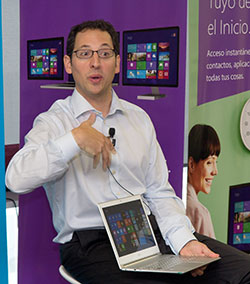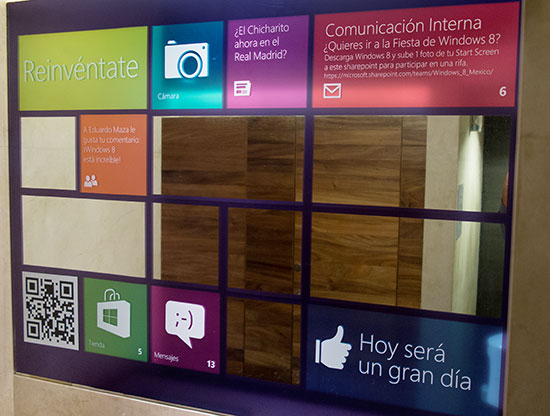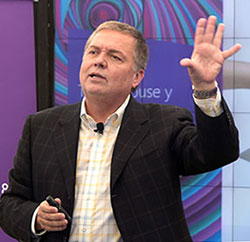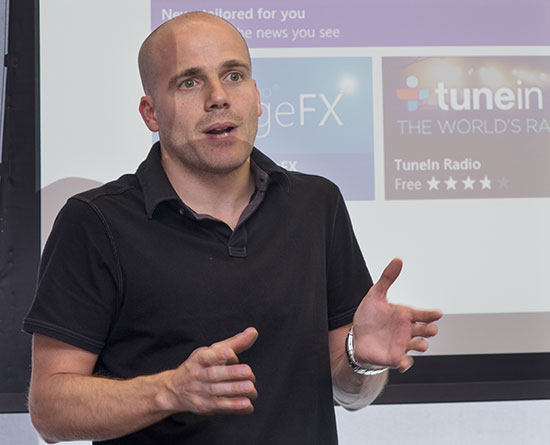New Windows for Microsoft
05/11/12 21:05 Filed in: BitDepth+
Full reporting for the Business Guardian on Microsoft's launch of Windows 8 for the Latin American region in Mexico City.
Rethinking Windows for a new age
Reporting from the Latin American launch of Windows 8 in Mexico City for the Business Guardian, originally published on November 01, 2012.
 Chris Capossela, Microsoft Chief Marketing Officer, briefing the Latin American press corps.
Chris Capossela, Microsoft Chief Marketing Officer, briefing the Latin American press corps.
Photography by Mark Lyndersay.
The launch of Windows 8 a week ago was a pivotal moment for Microsoft and not just because it’s a new computer operating system from the company that essentially owns the world’s virtual desktops. This is a release that’s likely to define the fortunes of the company in the future.
Bold statements stood out at the launch; Windows Reimagined and Microsoft: All In.
Both were tag lines touted at the New York City launch event and both go some distance in explaining just how important this release of Windows is to the company.
Windows Reimagined addresses the significant absence of the market leader in computer operating systems in the two fastest growing markets of modern technology, tablets and smartphones.
The company had an early lead in tablet PCs, supporting a line of chunky laptops with reversible keyboards at the turn of the century that pleased geeks and almost nobody else. Microsoft also had a smartphone focused operating system (OS) early, competing with early Palm based devices but the product proved to be notoriously bloated and slow.
Both products limped along in the market place until the paradigm changed and sleek, touchscreen and usable became the watchwords in handheld mobile devices.
Now Microsoft is making a fresh effort at reclaiming its stake in these lucrative markets, deploying an OS that runs on a range of devices and putting an emphasis on PC designs that merge the worlds of tablet and notebook into a single device.
At a media briefing at Microsoft Latin America’s Technology Center in Mexico City last week, Chris Capossela, Chief Marketing Officer explained the key selling point of the new version of Windows.
“Most people don’t get how flexible Windows is. It runs huge servers in large corporations, and it runs on phones and on gas station screens,” Capossela said.
“We’re the only company that has a single user interface from the TV to the phone to the computer desktop.”
That user interface is now quite different from anything that’s gone before.
Windows 8 replaces the start button that’s been the key navigation point for PC users for decades with a start screen full of colourful tiles that launch software and in some cases, constantly update information like weather, Facebook statuses and news feeds.
The large tiles are designed for computers driven by touch and are likely to prove useful on the flood of Windows based tablet PCs (more than 1,000 models have been certified by Microsoft) that will be coming to market over the next few weeks.
The company is banking on attractive hardware choices, a new touch based interface on its mainstream OS, a motivated developer community and hardware partners keen on a surge in flat sales growth to drive widespread adoption of Windows 8 and to provide the foundation of a new era of Windows.
Consolidating the company’s commitment to moving its operating system into a competitive role in mobility computing was this Monday’s launch of Windows Phone 8.
After sluggish financial performance over the last few months, Microsoft is banking on the scale of its ecosystem (see Big Numbers, below) to drive growth in its marketshare.
“What are your expectations?” was the first question from the Latin American press corps to Chris Capossela.
“Great success is my expectation,” Capossela responded with a wide, confident grin.
Big Numbers

Privy to their secrets. Microsoft’s commitment to Windows 8 is everywhere, even in the washrooms at the company's Mexico City headquarters.
Photography by Mark Lyndersay.
Microsoft Global...
Windows 8 is a global release in 231 markets in 109 languages supported by marketing in 40 countries.
There are 670 million active licenses of Windows 7 in use worldwide.
The public beta previews of Windows 8 attracted 16 million downloads.
Microsoft’s personal (and free) cloud solution Skydrive hosts 240 million users who store 14 petabytes of data in the cloud.
The company expects 400 million devices to be running Windows 8 in its first year of release.
“Hundreds of thousands” of retail sales staff and vendors have been trained to explain the features of Windows 8. Visit expertzone.microsoft.com to find out about certification and personal rewards for training.
Microsoft in Latin America...
There are 25 offices serving 40 countries in the region. More than a milion people work in the Microsoft ecosystem in the region and the company partners with 70,000 businesses and developers.
There are 70 million Windows licenses active in the region and 12,000 developers working on software for the Windows store.
The company expects to sell 49 million PCs running Windows 8 in the region in the software’s first year of release.
Microsoft works with 1,000 companies in the region who manufacture PCs to prepare them for Windows 8.
What’s in Windows 8?
 Hernan Rincon, President of Microsoft Latin America introduces Windows 8 at the Hotel Downtown, Mexico City.
Hernan Rincon, President of Microsoft Latin America introduces Windows 8 at the Hotel Downtown, Mexico City.
Photography by Mark Lyndersay.
At the heart of Windows 8 is a core OS that’s almost indistinguishable from the successful Windows 7, the software that quickly supplanted the unhappy release of Windows Vista on the hard drives of most PC users.
The good news for Windows 7 users is that all the software they are using successfully on their current systems will also work on Windows 8 and their computers are already up to specification for the new release.
The biggest new difference for an upgrading Windows 7 user will be the bold presence of the new green start screen with its vividly coloured tiles. At first glance, an experienced Windows user might be inclined to dismiss this new interface (Microsoft calls it the Modern UI), as a touch optimised and somewhat overblown replacement to the start button.
That would be a mistake. The new start screen is, in fact, a new operating system all on its own and one that’s capable of operating independent of the desktop OS that until now has been all the Windows we’ve ever known.
On Windows RT based tablets, which run on the ARM mobile processor (taking advantage of that hardware platform’s stingy power requirements and fast processors), there is no Windows desktop at all. On those tablet PCs, the only OS is the Modern UI and the only apps that run on such systems will appear as touchable tiles.
To keep such devices eligible for business use, all will ship with a Modern UI version of the Office suite as part of the standard installation.
“Consumers are choosing devices because of the beauty of the device,” explained Chris Capossela, “but they are also buying it for an ecosystem that allows them to do different things.”
Curiously, the Microsoft Surface tablet was absent at the Latin American launch. Many of the devices on show there were updates on the Ultrabook form factor, some reincarnating various forms of swivelling monitors that folds the keyboard away and put the screen front and centre.
It’s early days yet to gauge customer reaction to these new tablet PCs, but it seems unlikely that anyone used to what’s now understood to be a tablet computer is going to want to walk around with one that has a deactivated keyboard attached to it.
The sweet spot is likely to come in convertible tablet PCs that follow the model of the Surface’s snap on keyboard but merge that principle with Ultrabook style.
Attach the keyboard and you have an Ultrabook, remove it and you have a tablet. Seeing the device in use is the best sales pitch you can imagine.
Look to devices like the HP Envy x2, Asus Eee Pad Transformer and the Fujitsu Stylistic q702 as examples of a Windows 8 tablet PC design that’s likely to take off quickly.
“Are these new devices PCs?” asked Steve Ballmer at the New York City launch.
“Yes. Are these new devices tablets? Yes. Some of them flip. Some of them convert. Some of them attach.”
To drive development of new software for what’s essentially a new OS, Microsoft has developed the Windows Store, another Modern UI tile and service that delivers downloadable software quickly and affordably (see It’s all about the Apps, below).
This new way of doing things isn’t as confusing as its worst critics argue, but layering two operating systems in this way is likely to puzzle casual users.
To manage that, on startup there’s a brief video that explains how the Start screen works and a there’s a leaflet in every system that ships with Windows 7 that also explains the new way of working.
At the Windows 8 launch in New York City, Julie Larson-Green, Windows 8 Experience Head, said: “Once you get one PC with touch, you’ll want to get all your PCs with touch.”
That sounds about right.
Working effectively with Windows 8 takes a little time but is particularly rewarding on a tablet-based form factor. You get a full PC when you need it and a simpler touch interface if you prefer.
It’s all about the Apps

Eduardo Mangarelli, Director of Technology, Developers & Platform Group, Microsoft Latin America explains the company’s strategy with the new Windows Store.
Photography by Mark Lyndersay.
Perhaps the strongest media briefing at Microsoft’s Latin American launch of Windows 8 came from Uruguay’s Eduardo Mangarelli the company’s Director of Technology, Developers and Platform group for the region.
Mangarelli’s challenge will be to evangelise the Windows Store for new Modern UI apps to developers in the LatAm region, but he has a few assets on his side.
Beyond the expected uptake of Windows 8 on new computers and upgrades from Windows 7 users, there are the growth prospects on tablets and phones as Microsoft finally makes a credible entry into that mobile computing space.
Key to the success of the new software store is the fact that it’s one store serving the every Windows 8 computer. A developer who chooses to distribute to the entire global distribution of Windows 8 will have a product reaching hundreds of millions of customers with a single upload.
“The store,” said Mangarelli, “will drive development and offer local content and locally developed apps that serve local needs.”
Not all apps make sense for global distribution and language issues will probably mandate regional releases for most Modern UI apps, so developers can choose which regions their software will be available in.
“Microsoft offers advertising and commerce models which are optional for developers,” explained Mangarelli, “Developers coming from different platforms, even HTML 5, can easily develop for Windows 8.”
Modern UI apps created for the Windows Store will run on Windows RT, but not on Windows Phone 8, though developers will find that they can reuse parts of their code base in developing for both platforms.
“Developers make more money on Windows than on Apple or Android,” said Chris Capossela. “The enthusiasm is so incredibly high.”
Microsoft also sweetens the post for developers by offering an initial revenue split of a standard 70/30 on the cost of any paid software, but once an app earns more than US$25,000, the split goes to 80/20.
Everything you might ever want to know about the launch of Windows 8 is linked here…
BitDepth#859, Expect Turbulence
BitDepth#858, Microsoft: All In
Working with Windows 8 on a tablet device...
BitDepth#857, Is it the tablet PC's time?
BitDepth#856, Software for the Modern UI
BitDepth#855, Tailoring a Tablet-ready Windows
BitDepth#854, Windows 8 on a Slate
Reporting from the Latin American launch of Windows 8 in Mexico City for the Business Guardian, originally published on November 01, 2012.

Photography by Mark Lyndersay.
The launch of Windows 8 a week ago was a pivotal moment for Microsoft and not just because it’s a new computer operating system from the company that essentially owns the world’s virtual desktops. This is a release that’s likely to define the fortunes of the company in the future.
Bold statements stood out at the launch; Windows Reimagined and Microsoft: All In.
Both were tag lines touted at the New York City launch event and both go some distance in explaining just how important this release of Windows is to the company.
Windows Reimagined addresses the significant absence of the market leader in computer operating systems in the two fastest growing markets of modern technology, tablets and smartphones.
The company had an early lead in tablet PCs, supporting a line of chunky laptops with reversible keyboards at the turn of the century that pleased geeks and almost nobody else. Microsoft also had a smartphone focused operating system (OS) early, competing with early Palm based devices but the product proved to be notoriously bloated and slow.
Both products limped along in the market place until the paradigm changed and sleek, touchscreen and usable became the watchwords in handheld mobile devices.
Now Microsoft is making a fresh effort at reclaiming its stake in these lucrative markets, deploying an OS that runs on a range of devices and putting an emphasis on PC designs that merge the worlds of tablet and notebook into a single device.
At a media briefing at Microsoft Latin America’s Technology Center in Mexico City last week, Chris Capossela, Chief Marketing Officer explained the key selling point of the new version of Windows.
“Most people don’t get how flexible Windows is. It runs huge servers in large corporations, and it runs on phones and on gas station screens,” Capossela said.
“We’re the only company that has a single user interface from the TV to the phone to the computer desktop.”
That user interface is now quite different from anything that’s gone before.
Windows 8 replaces the start button that’s been the key navigation point for PC users for decades with a start screen full of colourful tiles that launch software and in some cases, constantly update information like weather, Facebook statuses and news feeds.
The large tiles are designed for computers driven by touch and are likely to prove useful on the flood of Windows based tablet PCs (more than 1,000 models have been certified by Microsoft) that will be coming to market over the next few weeks.
The company is banking on attractive hardware choices, a new touch based interface on its mainstream OS, a motivated developer community and hardware partners keen on a surge in flat sales growth to drive widespread adoption of Windows 8 and to provide the foundation of a new era of Windows.
Consolidating the company’s commitment to moving its operating system into a competitive role in mobility computing was this Monday’s launch of Windows Phone 8.
After sluggish financial performance over the last few months, Microsoft is banking on the scale of its ecosystem (see Big Numbers, below) to drive growth in its marketshare.
“What are your expectations?” was the first question from the Latin American press corps to Chris Capossela.
“Great success is my expectation,” Capossela responded with a wide, confident grin.
Big Numbers

Privy to their secrets. Microsoft’s commitment to Windows 8 is everywhere, even in the washrooms at the company's Mexico City headquarters.
Photography by Mark Lyndersay.
Microsoft Global...
Windows 8 is a global release in 231 markets in 109 languages supported by marketing in 40 countries.
There are 670 million active licenses of Windows 7 in use worldwide.
The public beta previews of Windows 8 attracted 16 million downloads.
Microsoft’s personal (and free) cloud solution Skydrive hosts 240 million users who store 14 petabytes of data in the cloud.
The company expects 400 million devices to be running Windows 8 in its first year of release.
“Hundreds of thousands” of retail sales staff and vendors have been trained to explain the features of Windows 8. Visit expertzone.microsoft.com to find out about certification and personal rewards for training.
Microsoft in Latin America...
There are 25 offices serving 40 countries in the region. More than a milion people work in the Microsoft ecosystem in the region and the company partners with 70,000 businesses and developers.
There are 70 million Windows licenses active in the region and 12,000 developers working on software for the Windows store.
The company expects to sell 49 million PCs running Windows 8 in the region in the software’s first year of release.
Microsoft works with 1,000 companies in the region who manufacture PCs to prepare them for Windows 8.
What’s in Windows 8?

Photography by Mark Lyndersay.
At the heart of Windows 8 is a core OS that’s almost indistinguishable from the successful Windows 7, the software that quickly supplanted the unhappy release of Windows Vista on the hard drives of most PC users.
The good news for Windows 7 users is that all the software they are using successfully on their current systems will also work on Windows 8 and their computers are already up to specification for the new release.
The biggest new difference for an upgrading Windows 7 user will be the bold presence of the new green start screen with its vividly coloured tiles. At first glance, an experienced Windows user might be inclined to dismiss this new interface (Microsoft calls it the Modern UI), as a touch optimised and somewhat overblown replacement to the start button.
That would be a mistake. The new start screen is, in fact, a new operating system all on its own and one that’s capable of operating independent of the desktop OS that until now has been all the Windows we’ve ever known.
On Windows RT based tablets, which run on the ARM mobile processor (taking advantage of that hardware platform’s stingy power requirements and fast processors), there is no Windows desktop at all. On those tablet PCs, the only OS is the Modern UI and the only apps that run on such systems will appear as touchable tiles.
To keep such devices eligible for business use, all will ship with a Modern UI version of the Office suite as part of the standard installation.
“Consumers are choosing devices because of the beauty of the device,” explained Chris Capossela, “but they are also buying it for an ecosystem that allows them to do different things.”
Curiously, the Microsoft Surface tablet was absent at the Latin American launch. Many of the devices on show there were updates on the Ultrabook form factor, some reincarnating various forms of swivelling monitors that folds the keyboard away and put the screen front and centre.
It’s early days yet to gauge customer reaction to these new tablet PCs, but it seems unlikely that anyone used to what’s now understood to be a tablet computer is going to want to walk around with one that has a deactivated keyboard attached to it.
The sweet spot is likely to come in convertible tablet PCs that follow the model of the Surface’s snap on keyboard but merge that principle with Ultrabook style.
Attach the keyboard and you have an Ultrabook, remove it and you have a tablet. Seeing the device in use is the best sales pitch you can imagine.
Look to devices like the HP Envy x2, Asus Eee Pad Transformer and the Fujitsu Stylistic q702 as examples of a Windows 8 tablet PC design that’s likely to take off quickly.
“Are these new devices PCs?” asked Steve Ballmer at the New York City launch.
“Yes. Are these new devices tablets? Yes. Some of them flip. Some of them convert. Some of them attach.”
To drive development of new software for what’s essentially a new OS, Microsoft has developed the Windows Store, another Modern UI tile and service that delivers downloadable software quickly and affordably (see It’s all about the Apps, below).
This new way of doing things isn’t as confusing as its worst critics argue, but layering two operating systems in this way is likely to puzzle casual users.
To manage that, on startup there’s a brief video that explains how the Start screen works and a there’s a leaflet in every system that ships with Windows 7 that also explains the new way of working.
At the Windows 8 launch in New York City, Julie Larson-Green, Windows 8 Experience Head, said: “Once you get one PC with touch, you’ll want to get all your PCs with touch.”
That sounds about right.
Working effectively with Windows 8 takes a little time but is particularly rewarding on a tablet-based form factor. You get a full PC when you need it and a simpler touch interface if you prefer.
It’s all about the Apps

Eduardo Mangarelli, Director of Technology, Developers & Platform Group, Microsoft Latin America explains the company’s strategy with the new Windows Store.
Photography by Mark Lyndersay.
Perhaps the strongest media briefing at Microsoft’s Latin American launch of Windows 8 came from Uruguay’s Eduardo Mangarelli the company’s Director of Technology, Developers and Platform group for the region.
Mangarelli’s challenge will be to evangelise the Windows Store for new Modern UI apps to developers in the LatAm region, but he has a few assets on his side.
Beyond the expected uptake of Windows 8 on new computers and upgrades from Windows 7 users, there are the growth prospects on tablets and phones as Microsoft finally makes a credible entry into that mobile computing space.
Key to the success of the new software store is the fact that it’s one store serving the every Windows 8 computer. A developer who chooses to distribute to the entire global distribution of Windows 8 will have a product reaching hundreds of millions of customers with a single upload.
“The store,” said Mangarelli, “will drive development and offer local content and locally developed apps that serve local needs.”
Not all apps make sense for global distribution and language issues will probably mandate regional releases for most Modern UI apps, so developers can choose which regions their software will be available in.
“Microsoft offers advertising and commerce models which are optional for developers,” explained Mangarelli, “Developers coming from different platforms, even HTML 5, can easily develop for Windows 8.”
Modern UI apps created for the Windows Store will run on Windows RT, but not on Windows Phone 8, though developers will find that they can reuse parts of their code base in developing for both platforms.
“Developers make more money on Windows than on Apple or Android,” said Chris Capossela. “The enthusiasm is so incredibly high.”
Microsoft also sweetens the post for developers by offering an initial revenue split of a standard 70/30 on the cost of any paid software, but once an app earns more than US$25,000, the split goes to 80/20.
Everything you might ever want to know about the launch of Windows 8 is linked here…
BitDepth#859, Expect Turbulence
BitDepth#858, Microsoft: All In
Working with Windows 8 on a tablet device...
BitDepth#857, Is it the tablet PC's time?
BitDepth#856, Software for the Modern UI
BitDepth#855, Tailoring a Tablet-ready Windows
BitDepth#854, Windows 8 on a Slate
blog comments powered by Disqus

